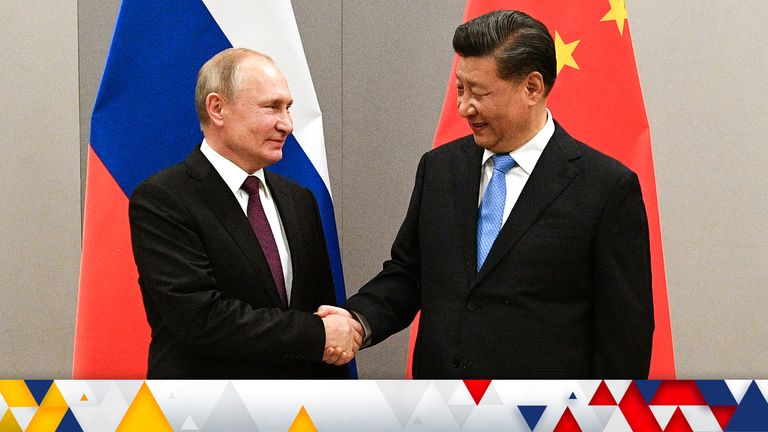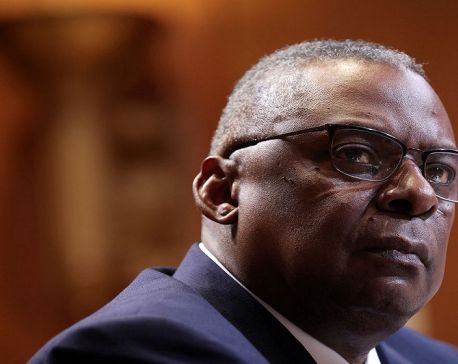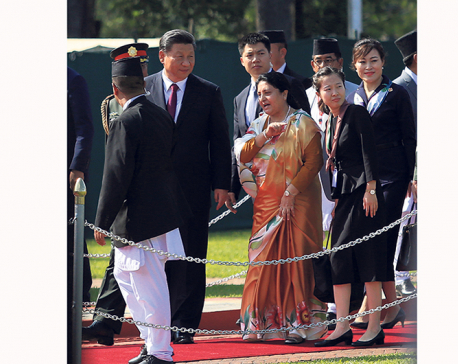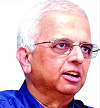
OR
Opinion
Underlying messages of the Xi-Putin summit
Published On: April 9, 2023 08:30 AM NPT By: Dr Dinesh Bhattarai

United States Relations with China (290) and Cold War International History Project Bulletin contain records of correspondences between Mao Zedong and Josef Stalin, 13 January 1949, (6-7, 27-28) stating that on January 8, 1949, when Chiang Kai-shek appealed to the United States, the Soviet Union, Britain and France to mediate in the ongoing civil war in China, Stalin immediately sought to persuade Mao to accept a Soviet mediation, a mediation that if successful would have resulted in a divided China- Stalin’s optimum outcome. Mao’s reply on January 13, the records say, was blunt and to the point – a response remarkable for its assertion of the Chinese Communist Party’s (CCP) interests over Moscow’s. In reply, Mao declared: “It is for the people of China itself to choose the way to achieve peace, unity and democracy… The government of the USSR (Union of Soviet Socialist Republics) … cannot accept mediation between the two sides. Victory, Mao said, “is already in sight” and “the balance of class forces in China has already changed irreversibly. We are therefore inclined,” Mao said, toward “the unconditional surrender of the Nanking government.” Stalin would not relent and say refusal would be to give up “the banner of peace into the hands of the Kuomintang.”
In seventy-four years of that mediation offer from the Soviet Union to China, the world has witnessed profound transformations in political, and socio-economic, geographical theaters. On October 1, 1949, CCP defeated the Kuomintang led nationalist government and proclaimed the founding of the People’s Republic of China. In the 1950s, Mao’s China saw the Soviet Union as the leader of the Communist bloc. America’s China scholar Michael Pillsbury writes “the Chinese feigned and sought aid and assistance from the more technologically advanced Russians… The Chinese had secret dreams of surpassing the Soviet Union, and that they would not just stop there-their next target would be the Americans. China would not play second fiddle. China would follow its own playbook, and that meant doing everything possible to become the dominant actor on the global stage.” (The Hundred-Year Marathon, p.21, 26). The Cold War (1945-1990), witnessed geopolitics making sharp twists and turns. In March 1969, there were violent clashes between the Chinese and the Soviet Union along the Ussuri River that formed the boundary between them. US President Richard Nixon traveled to Beijing in 1972. The United States and China came together against the Soviet Union . The Cold War ended in 1989. The Soviet Union, one of the poles that divided the world into the free and socialist bloc, disintegrated with associated republics declaring their own independence. Post-Cold War ensued. The onset of the euphoric moment led political scientists declaring the “end of history” and liberal ideology with no alternative. There was a unipolar moment with the United States remaining the sole superpower in the post-Cold War era.
The progress of the most populous country- China within a short span of time transformed it from a predominantly agriculture country to the largest trading and manufacturing nation, and the second largest economy of the world, with no parallel seen in contemporary world history. China, with, only 7% of the world’s arable land, 7% of the world’s fresh water, 3% of the world’s forests, 2% of the world’s oil and 1% of the natural gas, is supporting 20% of the world’s population. (John Thornton: Assessing the next phase of a rising China). It is now the only challenger to the sole superpower- the United States. An “intense competition “is underway,” in words of US Secretary of State Anthony Blinken “to shape, to determine what comes next.” The year-long Russia’s war against Ukraine has come at the center of this “intense competition,” reviving the competing spheres of influence. Geopolitical tensions are rising higher as the war in Ukraine continues. Reports indicate Russia deploying tactical nuclear weapons close to Belarus’ borders with NATO (North Atlantic Treaty Organization) countries amid growing tensions and more economic and military support from the United States and Europe for Ukraine. This is likely to lead to broader escalation, and prompt China, with “no limits to partnership” to consider transferring military aid to Russia, which may invite the use of sanctions from the West.
It is against this backdrop; this article attempts to briefly look at the Xi-Putin summit in Moscow last month, and underlying messages:
After assuming top leadership in 2013, Chinese President Xi Jinping made the first foreign visit to Russia. Since then, Xi has visited Russia eight times. Xi describes Russian President Vladimir Putin as his “best, most intimate friend,” and Putin returns the compliment lauding Xi as a “reliable friend and good partner.” The two leaders have met in sessions 40 times, more than any world leaders. On February 4, 2022, they released a joint communique on the Sino-Russia alignment declaring each party’s commitment to a “partnership” with “no limits.” These are strong signs of support from China to Russia, and their mutual desire for deeper economic and political cooperation as well.
President Xi had three full days of talks (March 20-23)with his counterpart in Moscow. They discussed building a second oil pipeline to carry Siberian natural gas to China, and solidifying the increasingly close trajectory of Russia -China relations beyond the country’s current two leaders and their personnel relationship. Russia recently became China’s critical source of cheap energy and natural resources accounting for nearly a third of all Russian exports. China and Russia have been the largest trading partners. Trade between them is $189 billion and projected to exceed $200 billion as early as this year. Joint economic cooperation statement talks of using Chinese renminbi in lieu of the American dollar to settle cross border trade including for oil and gas. This is considered vital to China’s push to replace the US as the world superpower and erode the dollar's dominance in global transactions. With the Belt and Road Initiative (BRI), China’s influence is spreading well beyond Asia into Africa, even Latin America and Europe.
The visit took place at a time when there was a growing reception to the Iran-Saudi Arabia peace deal which Beijing brokered between these two arch rivals in the Persian Gulf. China wanted to capitalize the deal, show the declining capacity of the West and present itself as a credible mediator, and “peacemaker” with its 12-point peace plan aimed at ending the fighting in Ukraine. The peace plan entitled “China’s Position on the Political Settlement of the Ukraine Crisis,” and unveiled coinciding the anniversary of Russia’s invasion of Ukraine on February 24, 2023, contains twelve points: “respecting the sovereignty of all countries, abandoning the Cold War mentality, ceasing hostilities, resuming peace talks, resolving the humanitarian crisis, protecting civilians and prisoners of wars (POWS), keeping nuclear power plants safe, reducing strategic risks, facilitating grain exports, stopping unilateral sanctions, keeping industrial and supply chains stable, and promoting post conflict reconstruction.”
Earlier Turkey had helped broker the grain export deal between Moscow and Kyiv. As Turkey is a member of NATO, its attempts were not going far to facilitate a peace plan.
The “hiding and biding” approach in international relations of the Deng era has been transformed into “striving for achievements,” and the “rejuvenation of the Chinese nation.” The implications of this transformation can be seen in showcasing China as a potential powerbroker from everything from trade routes to foreign territorial disputes to restoring the past glory. President Putin welcomed China’s constructive role and said he has carefully studied the 12-point peace plan and was open to peace talks. The West’s dismissal of the 12-point peace plan put forward by Beijing, gives Beijing a window to present itself as a nation of peace, and peace maker. The two leaders were reported to have discussed the war in Ukraine, increasing military technical cooperation between China and Russia. They issued a Joint Statement of the People’s Republic of China and the Russian Federation on Deepening the Comprehensive Strategic Partnership of Coordination for the New Era. China views Russia as its only major ally that both share their desire of establishing an alternative to the Western liberal order.
Xi authored an article on the eve of the visit in Rossiyskaya Gazeta, the Kremlin official newspaper, that this trip “was a journey of friendship, cooperation and peace.” He described bilateral relations as “matured and resilient” and “setting a new model of great power relations.” He appreciated Putin’s leadership and that Russia “has made great strides under his strong leadership.” Putin wrote a parallel article in People’s Daily, the mouthpiece of the CPC, recalled Xi is an old friend with whom he has a ‘particularly cordial’ relationship. Putin was of the view that, “the crisis in Ukraine was provoked and fueled by the West, a manifestation of its desire to retain its international dominance and preserve the unipolar world order.” He said, “Ukraine war was a product of NATO aggression, and has bought opinion on the global South.”
Xi and Putin were reported to have discussed Taiwan -- a major source of tension between China and the U.S. Russia supports Beijing's "one China" principle and acknowledges Taiwan to be an inalienable part of China, according to the joint statement. China equates the “rejuvenation of the Chinese nation,” with the essence of the “unification of the motherland.” The two leaders called for a multipolar world order and expressed concerns over the AUKUS security pact between the U.S., the U.K. and Australia.
Underlying Messages
What President Xi told his Russian counterpart following a farewell dinner at the Kremlin reflects his desire to be in the driving seat: “right now there are changes the likes of which we have not seen for 100 years. And we are the ones driving these changes together.”
On March 21, Xi said, “Chinese-Russian ties have gone beyond bilateral relations and are of vital importance for the modern world order and the fate of mankind.” China has begun to more aggressively challenge America’s role as a key economic and political actor in Asia. US Secretary of State Anthony Blinken says, the stakes in Ukraine go well beyond Ukraine… and have “a profound impact in Asia.”
President Xi’s visit is seen as “a huge demonstration of Russia and China friendship, giving legitimacy to Putin,” said Jakub Jakobowski, a fellow at the Mercator Institute for China Studies (MERICS). “Despite this great strategic blunder that Putin made last year, he is still an important asset that China does not want to lose.” The visit is also seen as a growing solidarity with the Russian leader as it came at a time when President Putin was issued an arrest warrant by the International Criminal Court (ICC) for “devastating war crimes.”
The peace plan floated by China is being interpreted as being “a constructive force that China is not simply fully siding with Russia but is trying to create peace.” It is a demonstration of increasing influence to present itself as a “potential peacemaker” and help resolve foreign disputes. While Kyiv says there can be no alternative for full restoration of Ukraine’s territorial integrity, it also refers to the Minks I and Minsk II agreement brokered by Paris and Berlin in the mid-1990s.
For a peace-making role, both sides need to show their trust to the peace broker. China seems to have earned it as the fundamental principle of the Chinese foreign policy is noninterference in internal affairs and respect for sovereignty and territorial integrity of the nation. Ukrainian President Vlodomir Zelensky is seen to engage with Beijing, and talk to the Chinese President who had said during the visit that he would speak with President Zelensky. Ukrainian foreign minister Dymtro Kuleba says, “China is testing the ground whether it wants to engage fully in the peace process to end Russia’s war against Ukraine. He thinks China “will not allow Russia to collapse, but they think they would need a weak Russia to make concessions to China to provide resources.”
The two leaders’ message to the West was the collective criticism of their political systems saying they “oppose the hypocritical narrative of the so-called democracy against authoritarianism.” President Xi agrees to Putin’s framing of the Ukraine conflict as part of a larger effort by the West to contain rival powers and prevent what Putin calls a historical shift towards a “multipolar world.” Common to them is that both consider the US-led West is aligned against them and prevent them from their rise. The two are increasingly ideologically aligned in their opposition to the US-led order.
From here, says Prof. Sharyl Cross at George Marshall European Center for Security Studies, Germany, says: Xi seeks to assume a leading diplomatic role on the world stage. They have a shared interest in challenging the world order led by the US and its democratic allies. Political mutual trust is deepening and between Moscow and Beijing and common interests are multiplying. They called for “acceleration of the process of establishing a multipolar world order.”
President Xi sought to portray China as an honest broker in any potential diplomatic effort, saying, “we are always for peace and dialogue. We stand firmly on the right side of history.” However, China’s peace plan has no provisions for returning Ukrainian territory seized by Russia. Peace plan would require the painful troops withdrawal and territorial concessions on part of the Russian President which seems highly unlikely. President Putin remains committed to the idea that Russia and Ukraine are one country and considers Ukraine as a part of Russia’s “historical lands.” Putin has been issuing a narrative that war in Ukraine as being “about the very existence of our country.”
The visit is also seen to be showcasing his “more control over where the relationship is going.” Political pundits see the visit as a diplomatic boon for Putin. Consolidating and developing China-Russia relations is a strategic choice made by China based on its fundamental interests. The Guardian columnist Rafael Behr, says, “The Chinese president is not Putin’s friend, he is a patron taking homage from a client,” and adds Moscow’s remaining increasingly tied to Beijing would be problematic, for its economic and political fate. Power imbalance is deepening. China’s domination of Russia is complete, argues co-author of Putin vs the People Sam Greene, and adds “Putin mortgaged the Kremlin to Beijing.”
The timing of the Moscow summit was also seen in the context of US President convening of the Second Summit for Democracy on March 29-30, and intention to create a divide in the West. China and Russia see the Democracy Summit “as a potential architecture for international cooperation to oppose them on the world stage.”
Lessons to be learned: understand the severity and complexity of geopolitical changes and challenges
At the time when the outbreak of Covid-19 pandemic, fuel, food security and climate change were accelerating geopolitical developments, Russia’s war against Ukraine came to compound the “intense competition,” reviving the competing spheres of influence. Taken together, these dynamics are driving nations to prioritize protecting their economic and security interests and avoid getting embroiled in the ongoing tensions/competition in order to preserve their sovereignty and independence. During the Cold War in the 20th century, Europe was the main theater of the US-Soviet competition. Much of Europe was with the US, only a few taking different tracks. The current geopolitical focus is on the Indo-Pacific region- comprising large areas of both the Indian and Pacific Ocean. Telling them to choose a side is not a practical and wise call. Countries should be left to make their own sovereign independent decisions in their interests, as they wish.
Non Aligned foreign policy in such a situation opens up options and opportunities. Nonalignment alone made it possible for countries in the region to publicly condemn Russia’s invasion of Ukraine and also through votes in the United Nations for the flagrant violation of international law and breach of the United Nations Charter, and at the same time maintain their relations. Early on, Nepal took the correct position of condemning the invasion of a small country by a big neighbor, and called for the cessation of hostilities and return to diplomatic talks to settle differences and disputes through peaceful means. Through non-aligned and balanced foreign policy, Nepal pursues its national interests and wishes to protect itself from rivalries to preserve its identity as a sovereign and independent nation.
In short to medium to long term, Nepal’s foreign policy should remain non-aligned that helps maintain close, cordial, progressive and productive relations with immediate neighbors India and China, while remaining constructively engaged with the major powers and the wider international community. As India and China are emerging as the main theaters of the 21st century geopolitics and geoeconomics, Nepal must take more progressive and critical steps to learn the dynamics of the rapidly shifting geopolitics and thoroughly understand the underlying dynamics. Increasing engagements with the neighbours have been useful and telling us about each other, but we need to increase the pace, intensity and density of these engagements for mutual benefit. Nepal has not risen to the challenges of changes. It cannot remain indifferent and continue to cling to the past practices, and squander the national potential. The thought process must be widened, and deepened in a systematic, significant and sophisticated way to understand the interlocking complexities of changes and challenges that are unfolding every day.
You May Like This

China becoming more 'coercive and aggressive' - U.S. defence chief
SINGAPORE, June 11: The United States will do its part to manage tensions with China and prevent conflict even though... Read More...

External forces attempting to split China will be ruined: President Xi
KATHMANDU, Oct 14: Chinese President Xi Jinping has said that anyone attempting to split China will be ruined. ... Read More...

Mayday for protectionism
Whereas America built less than one million gross tons of ships between 2014 and 2016, South Korea and China produced a... Read More...









Just In
- Light rainfall likely in hilly areas of Koshi, Bagmati, Gandaki and Karnali provinces
- Customs revenue collection surpasses target at Tatopani border, Falls behind at Rasuwagadhi border in Q3
- Rain shocks: On the monsoon in 2024
- Govt receives 1,658 proposals for startup loans; Minimum of 50 points required for eligibility
- Unified Socialist leader Sodari appointed Sudurpaschim CM
- One Nepali dies in UAE flood
- Madhesh Province CM Yadav expands cabinet
- 12-hour OPD service at Damauli Hospital from Thursday











Leave A Comment